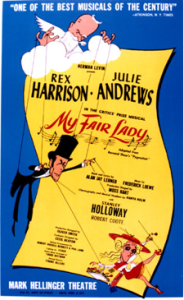My Fair Lady: The Myth, The Play, The Musical (Part 3)
Part 3 – The Musical
As we learned in last week’s blog, in the mid-1930’s, film producer Gabriel Pascal persuaded George Bernard Shaw for the rights to produce film versions of several of his plays, Pygmalion among them. And though audiences clamored for it, Shaw remained adamant that it not be adapted into a musical (after having had a bad experience with The Chocolate Soldier, a Viennese operetta based on his play Arms and the Man). If you want to listen to the songs played in this act, go to great-music.com so you can download them for free.
After Shaw’s death in 1950, Pascal revisited the idea and solicited lyricist Alan Jay Lerner’s expertise. Lerner agreed, and he and his composer partner Fritz Loewe began work. The team quickly realized that the play violated several key rules for constructing a musical: 1) as Shaw maintained, the main story was not a love story, 2) there was no subplot or secondary love story, and 3) there was no place for an ensemble. After some six months on the project, Lerner and Loewe decided it was impossible (like Rodgers and Hammerstein before them), gave up and parted ways.

In the years following, Gabriel Pascal died. Whilst trying to musicalize Lil’ Abner, Lerner read Pascal’s obituary and found himself once again preoccupied with the idea of a musical version of Pygmalion. When he and Loewe reunited, everything seemingly fell into place. The insurmountable obstacles that previously stood in their way disappeared and they excitedly began writing the show. They soon learned however that they were not the only ones seeking the musical rights to Pygmalion; MGM studios was also interested in the idea of adapting Shaw’s work and didn’t hesitate to exercise their influence when their lead executives called Lerner to discourage him from challenging the studio. Loewe said, “We will write the show without the rights, and when the time comes for them to decide who is to get them, we will be so far ahead of everyone else that they will be forced to give them to us.” For the next five months, the duo wrote, hired technical designers, and made casting decisions. When the time came to make a decision, Chase Manhattan Bank, who was in charge of Pascal’s estate and owned the rights to Pygmalion, awarded the musical rights to Lerner and Loewe.
The musical premiered on Broadway as My Fair Lady on March 15, 1956 at the Mark Hellinger Theatre in New York City with Rex Harrison and Julie Andrews in the leading roles. Originally announced as My Lady Liza, the name was changed when Harrison objected to a title based on the name of the female lead- Eliza Doolittle. (The new title was taken from the last line of the nursery rhyme, “London Bridge Is Falling Down” and appears nowhere in the musical.) It transferred to the Broadhurst Theatre and then The Broadway Theatre, where it closed on September 29, 1962 after 2,717 performances.
Haven’t seen My Fair Lady at Cygnet Theatre yet? It must close April 26th and shows are still selling out so hurry!